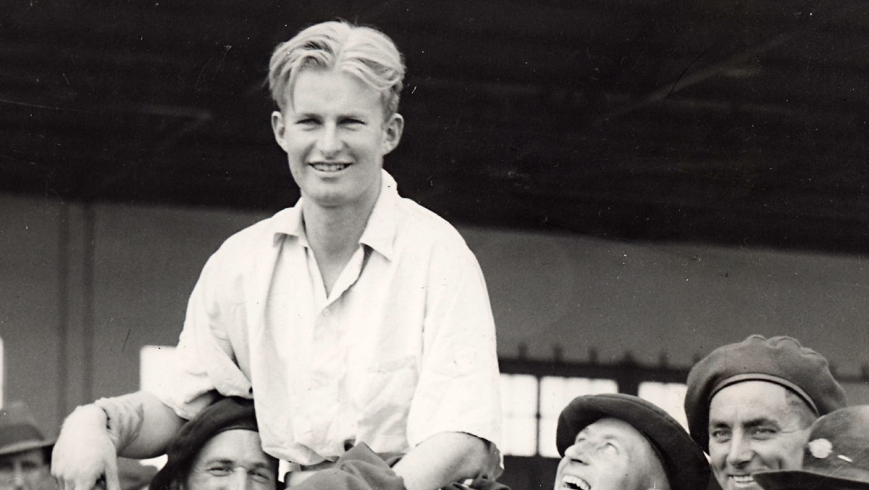The place was Melton, the date was 5 July 1936.
Cahill’s farm stood where Genesis Fitness Centre now stands. Mr and Mrs Cahill were milking their cows just after 8am. High above them, a tiny plane circled the town. A fierce storm with strong winds tore at the plane and, as those on the ground watched in horror, the plane began to disintegrate. The light framework was no match for the storm and the pilot fought to gain control.
Eyewitnesses watched in shock as one wing and part of the fuselage fell to earth. As the other wing was torn from the craft, the passenger also fell to earth, dying instantly. Within seconds the remains of the plane crashed with such force into Arnolds Gully that it split the rock on which it landed. The pilot was killed on impact.
The passenger in the ill-fated plane was Alexander Campbell who died leaving a wife and five small children. He was a mining engineer with Broken Hill Proprietary Company Ltd and the plane had been hired to take him from Essendon Airport to pick up other BHP executives from various outback towns before its final destination in Darwin.
The pilot of the plane was 22 year old Jimmy Melrose from Adelaide and all of Australia mourned his death. Some 100,000 people attended his funeral in Melbourne and a simultaneous service was held in Adelaide. School children lined the route as his body was taken from Melbourne’s St Paul’s Cathedral to Springvale for burial. Planes circled overhead. The South Australian parliament suspended its sittings and St Peter’s Cathedral in Adelaide was packed. Three planes flew over as the service ended.
Who was this young pilot whose death in a lonely paddock in Melton drew national mourning and packed two cathedrals?
In the 1930s Jimmy Melrose was one of Australia’s most talented young aviators. At a time when those magnificent men (and women) in their flying machines were breaking records and pushing limits, young Jimmy Melrose was right up there with them. He was the very image of the Western mythical hero – tall, blond, blue-eyed and good looking – and yet he was modest and unassuming. He did not smoke or drink alcohol and he kept himself fit. Australians loved him and the world honoured him, yet today he is a forgotten hero.
Charles James (Jimmy) Melrose was born on September 13, 1913 in Adelaide. His father, James Melrose, was a rich pastoralist and his mother was Hilda Westley Melrose née Billing. James Melrose died in 1922 leaving his widow Hilda and his only child, Jimmy.
Jimmy gained his pilot’s licence at the age of nineteen. He bought his first plane, a DH Puss Moth fitted with a 120 horsepower (89 kW) Gypsy Major engine, and named it My Hildegarde after his mother. It was his mother’s enthusiasm, encouragement and wealth that assisted him in achieving his dreams but the skill and courage were all Jimmy’s as he very soon began to demonstrate.
In 1934, he flew 12,875 kilometres solo around Australia in 5 days 10 hours 57 minutes, beating the previous record by almost two days (i.e. 45 hours). Flying in to land his plane, Jimmy was surprised to see an endless line of cars driving to the air field. He had lost track of the days and decided it must be Saturday and all those people were heading for the Gawler Races. After landing, he asked a reporter what day it was.
“It’s Sunday, why?” the reporter asked.
“Well, what are those cars doing out here today?” Jimmy said.
“Why they’ve come to see you,” was the reply.
In the same year, on his 21st birthday, he left Adelaide in My Hildegarde to fly to England to enter a race from London to Melbourne held to celebrate the centenary of Melbourne. Arriving in London, he was surprised to learn that his solo flight which took eight days and nine hours had broken the record for the fastest flight between Australia and England. He had broken a world record before even entering the race back to Australia.
The London Daily Telegraph wrote “This young fellow of the ready smile, the easy witticism and cultured voice and accent, has just made aviation history and is to be ranked among the famous pilots of the day.”
The day of the great race dawned and 60,000 people went to the airfield to watch the take-off. Jimmy was the youngest entrant. The planes flew across the countryside east of London, over the Thames and the Channel of Dover, and headed for Australia.
Between Rome and Athens, Jimmy flew into a storm. He had a weather forecast but it was written in Italian and he wrote “(I) couldn’t make head nor tail of it.” He continued, “Never have I felt so scared in all my life, as when I flew up this valley 5,000 feet above sea level, with the mountains going up to 10,000 feet and more, all covered in snow.”
Further on, winds forced him off course over the Timor Sea and, 20 miles from Darwin, his fuel gauge showed “empty”. His engine continued to operate till four miles out of Darwin and then it sputtered and died. Silence. My Hildegarde and Jimmy were alone with the wind and the ocean.
Meanwhile, in Darwin, an excited crowd waited at the airfield. The sky was clear and they strained to catch the first glimpse of him. At 5:30 p.m. they saw him gliding high in the sky. He glided silently down in a wide swoop and made a perfect landing over half a mile from the official check point. Jumping out of the plane with his log book, he ran the final half mile to check in. A crowd of 200 people cheered him on.
From Darwin, the next check point was Charleville in Queensland. Twenty miles out of Charleville, the mailman, Mr Sands, saw a plane swoop over his car and land ahead of him in a clear patch of scrub country. He later reported, “This young fellow, Melrose, wearing shorts and a sun helmet got out and asked his way to Charleville. Apparently he thought he was off his course. He thanked me and made a perfect take off. He’s a casual customer all right.”
He arrived in Melbourne on October 31, 1934. He won third place in the Handicap section, he was the youngest aviator and the only pilot to fly the world’s greatest air race unaccompanied. Australia loved him. With his prize money he established a monoplane fund for the Aero Club of South Australia.
In November 1934 he set a South Australian altitude record over St Vincents Gulf and two months later he made the first non-stop flight from Adelaide to Tasmania, then set a record in his flight from Launceston to Sydney, arriving two hours before expected.
In November 1935, he was flying back to Australia from England where he had bought a new plane, a Percival Gull which he named Westley, his mother’s middle name. On this flight, he recorded sighting Charles Kingsford Smith and Tommy Pethybridge in the Lady Southern Cross over the Bay of Bengal. They passed him in their much faster plane. We now know this was the last sighting of Smithy before he vanished. When Jimmy arrived in Singapore and found that Smithy had not yet arrived, he joined the search for the missing airmen. He spent several days recording and filming his unsuccessful search. Smithy and Pethybridge were never seen again.
It’s hard for us in this age of instant global communication to realise how truly alone these flyers were on such long flights over vast oceans and land masses, and how anxiously people waited for their safe arrival. But, in spite of his many flights, it was not over oceans or great land masses that the young Jimmy Melrose met his death.
In January 1936, Jimmy sailed to England where he bought another plane, a Heston-Phoenix, which again he named after his mother, Billing which was her maiden name. This was to be his last plane. In April 1936 he flew the new plane home, dedicating the flight to the promotion of the centenary of South Australia. A crowd of 8000 people were waiting at the Parafield (Adelaide) Aerodrome to greet him.
Jimmy had bought the five-seater Heston-Phoenix to set up a charter business which he called “Adelaide to Anywhere”. He accepted a charter flight for BHP from Melbourne to Adelaide then through the Outback to Darwin.
Flying out of Melbourne on 5 July in shocking weather conditions, at 7:50 a.m., Jimmy and his passenger met their deaths only one hour later, 23 miles (37 kilometres) from take-off. Jimmy’s watch stopped at 8:34 a.m.
Australians heard with shock and disbelief that their young hero was dead. As the truth sank in, the Prime Minister of the day, Joseph Lyons, led Australians in mourning their “chivalrous young knight of the air”.
Who knows how much more he might have achieved had he lived.
There are streets in Melton named in his memory. Near the site of his fatal crash there is HIldegarde Close, also Billing Place, Westley Place and Aviator Place. A little further east, are Phoenix Circuit, Heston Street, Gypsy Lane and James Melrose Drive. In memory of his passenger, we have Campbell Court. And there is a little park near the scene of the crash, the C.J (Jimmy) Melrose Memorial Reserve in Springbank Way. One route to Melbourne’s Tullamarine airport takes you along Melrose Drive.
Jimmy Melrose deserves to be remembered for his achievements in the early days of Australia’s and the world’s aviation history. September 13 is the 100th anniversary of his birth. Let’s put him back in our history books.
Veronica Schwarz is a freelance writer, artist and web designer. http://www.veronicaschwarz.net/







